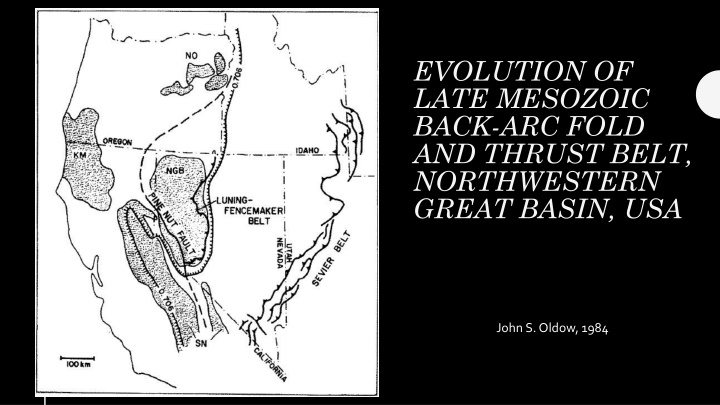
Late Mesozoic Back-Arc Fold and Thrust Belt in Northwestern Great Basin, USA
Explore the evolution and tectonic controls of the Late Mesozoic back-arc fold and thrust belt in the northwestern Great Basin, focusing on lithotectonic assemblages, the Luning Fencemaker thrust system, Mesozoic marine provinces, stratigraphic correlations, and structural history. Understand the relationship between Paleozoic basement, Mesozoic crust, and major thrust faults in this region.
Download Presentation

Please find below an Image/Link to download the presentation.
The content on the website is provided AS IS for your information and personal use only. It may not be sold, licensed, or shared on other websites without obtaining consent from the author. If you encounter any issues during the download, it is possible that the publisher has removed the file from their server.
You are allowed to download the files provided on this website for personal or commercial use, subject to the condition that they are used lawfully. All files are the property of their respective owners.
The content on the website is provided AS IS for your information and personal use only. It may not be sold, licensed, or shared on other websites without obtaining consent from the author.
E N D
Presentation Transcript
EVOLUTION OF LATE MESOZOIC BACK-ARC FOLD AND THRUST BELT, NORTHWESTERN GREAT BASIN, USA John S. Oldow, 1984
Motivation Understand how the Paleozoic basement controlled the deposition and deformation of Mesozoic crust in the NW Great Basin Use lithotectonic assemblages to aid in the interpretation of major thrust faults, as most of the Mesozoic crust does not have an exposed lower contact Describe the tectonic controls and timing on the Luning Fencemaker thrust system
Lithotectonic assemblages 8 assemblages delineated Generally separated by thrust faults Some are inferred Pine nut fault is an inferred left lateral strike slip fault Most laterally continuous is the Luning Fencemaker thrust which parallels the eastern boundary of the Mesozoic marine region
Mesozoic Marine Province Eastern and southern margins generally coincide with the Luning Fencemaker thrust system As mentioned before, most of the lower depositional contacts are not exposed, but where they are it is generally an angular unconformity with the underlying Paleozoic rocks In the southern extent, Mesozoic rocks are more volcanic, as conditions for marine deposition likely did not exist (area is underlain by continental crust)
Stratigraphic correlation Note similar stratigraphic make up of each assemblage, as well as lack of Paleozoic contact exposure
Structural history Structural history of the rocks east of the pine nut assemblage is very similar in terms of orientation, sequential development, and timing. The author breaks it up into 4 events: D1 more localized NW trending folding (Late Triassic to middle Jurassic) D2 Major widespread NW-SE shortening, resulting in NE trending structures (middle/late Jurassic early Cretaceous) D3 NW trending folds and thrusts that extend outside of the boundaries of the Mesozoic marine rocks (timing not well constrained) D4 Locally occurring minor deformation marking the final stage of deformation in this area The structural history of the region west of the pine nut assemblage is much different, and more closely aligned with the deformation of the Sierran arc Lack of lateral continuity of Mesozoic stratigraphy among mountain ranges Lack of NE trending D2 structures
Previous Tectonic Model tear fault model accounts for decoupling of Sierran block from the dismembered assemblages Amount of shortening in the back arc region is much greater than deformation in the Sierran block region The regional strike slip fault proposed here accounts for that decoupling and agrees with the long standing idea at this time of right oblique subduction However, how can the major NW-SE shortening (D2) of the back arc be explained by this model?
Proposed tectonic model Authors propose a long period of left lateral movement on Pine Nut fault This fault accommodated offset due to a change in subduction direction from NE to SE during that time This allows for the shortening direction observed in both the Luning- Fencemaker and Sevier thrust belts Ultimately right lateral movement that we know and love today was reinstated and overprints left lateral movement on the Pine Nut fault (basically now the Walker Lane) <17Ma
How is the Sevier tied in? Trend of the Sevier belt corresponds with the depositional hingeline inferred for the Paleozoic miogeocline The Sevier was active at the same time as the L-F for much of their histories Therefore, the authors consider them as paired back arc thrust belts They infer that the must be linked by some decollment at depth to account for quiet zone between them
Discussion A regional back arc fold and thrust belt developed in the Mesozoic marginal basin rocks which resulted in major NW-SE shortening from middle/late Jurassic to the early Creatceous Older Paleozoic crust controlled the deposition of Mesozoic rocks and the orientation and location of the L-F and Sevier thrust belts During this time the Sierran arc and the back arc region were decoupled by a regional left lateral strike slip fault The shortening axis of the L-F thrust belt is incompatible with the right oblique convergence direction, and thus an interval of left oblique subduction must have taken place to explain the development of it












